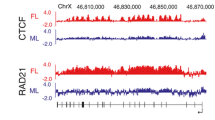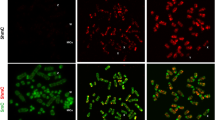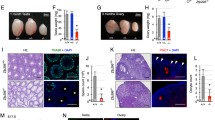Abstract
The male hypermethylated (MHM) region, located near the middle of the short arm of the Z chromosome of chickens, consists of approximately 210 tandem repeats of a BamHI 2.2-kb sequence unit. Cytosines of the CpG dinucleotides of this region are extensively methylated on the two Z chromosomes in the male but much less methylated on the single Z chromosome in the female. The state of methylation of the MHM region is established after fertilization by about the 1-day embryonic stage. The MHM region is transcribed only in the female from the particular strand into heterogeneous, high molecular-mass, non-coding RNA, which is accumulated at the site of transcription, adjacent to the DMRT1 locus, in the nucleus. The transcriptional silence of the MHM region in the male is most likely caused by the CpG methylation, since treatment of the male embryonic fibroblasts with 5-azacytidine results in hypo-methylation and active transcription of this region. In ZZW triploid chickens, MHM regions are hypomethylated and transcribed on the two Z chromosomes, whereas MHM regions are hypermethylated and transcriptionally inactive on the three Z chromosomes in ZZZ triploid chickens, suggesting a possible role of the W chromosome on the state of the MHM region.
Similar content being viewed by others
References
Barber DL, Sanders EJ, Aebersold R, Schneider WJ (1991) The receptor for yolk lipoprotein deposition in the chicken oocyte. J Biol Chem 266: 1876–18770.
Brockdorff N (1998) Th role of Xist in X-inactivation. Curr Opin Genet Devel 8: 32–333.
Brockdorff N, Ashworth A, Kay GF et al. (1992) The product of themouse Xist gene is a 15 kb inactive X-specific transcript containing no conserved ORF and located in the nucleus. Cell 71: 51–526.
Brown CJ, Ballabio A, Rupert JL et al. (1991) A gene from the region of the human X inactivation centre is expressed exclus-ively from the inactive X chromosome. Nature 349: 3–44.
Carter KC, Taneja KL, Lawrence JB (1991) Discrete nuclear domains of poly(A) RNA and their relationship to the functional organization of the nucleus. J Cell Biol 115: 119–1202.
Constaª ncia M, Pickard B, Kelsey G, Reik W (1998) Imprinting mechanisms. Genome Res 8: 88–900.
Dugaiczyk A, Haron JA, Stone EM, Dennison OE, Rothblum KN, Schwartz RJ (1983) Cloning and sequencing of a deoxyribonucleic acid copy of glyceraldehyde-3–phosphate dehydrogenase messenger ribonucleic acid isolated from chicken muscle. Biochemistry 22: 160–1613.
Feinberg AP, Vogelstein B (1983) A technique for radiolabeling DNA restriction endonuclease fragments to high specific activity. Anal Biochem 132:6-13.
Gubbay J, Collignon J, Koopman P et al. (1990) A gene mapping to the sex-determining region of the mouse Y chromosome is a member of a novel family of embryonically expressed genes. Nature 346: 24–250.
Hori T, Asakawa S, Itoh Y, Shimizu N, Mizuno S (2000) Wpkci, encoding an altered form of PKCI, is conserved widely on the avian W chromosome and expressed in early female embryos: Implication of its role in the female sex determination. Mol Biol Cell 11: 364–3660.
Kodama H, Saitoh H, Tone M, Kuhara S, Sakaki Y, Mizuno S (1987) Nucleotide sequences and unusual electrophoretic behavior of theWchromosome-specific repeating DNA units of the domestic fowl, Gallus gallus domesticus. Chromosoma 96: 1–25.
Kunita R, Nakabayashi O, Kikuchi T, Mizuno S (1997) Predominant expression of a Z-chromosome-linked immuno-globulin superfamily gene, ZOV3, in steroidogenic cells of ovarian follicles and in embryonic gonads of chickens. Dif-ferentiation 62: 6–70.
Lee JT, Davidow LS, Warshawsky D (1999) Tsix, a gene antisense to Xist at the X-inactivation centre. Nature Genet 21: 40–404.
Mizuno S, Whiteley HR, Whiteley AH (1973) The enrichment of egg-type RNA in cleavage stage embryos of the sand dollar Dendraster excentricus. Differentiation 1: 33–348.
Mizuno S, Tallman NA, Cox RF (1978) Estrogen withdrawal in chick oviduct. Characterization of RNA synthesized in isolated nuclei using a mercurated precursor. Biochim Biophys Acta 520: 18–202.
Nakabayashi O, Kikuchi H, Kikuchi T, Mizuno S (1998) Differential expression of genes for aromatase and estrogen receptor during the gonadal development in chicken embryos. J Mol Endocrinol 20: 19–202.
Nanda I, Shan Z, Schartl M et al. (1999) 300 million years of conserved synteny between chicken Z and human chromo-some 9. Nature Genet 21: 25–259.
Nanda I, Zend-Ajusch E, Shan Z et al. (2000) Conserved synteny between the chicken Z sex chromosome and human chromosome 9 includes the male regulatory gene DMRT1: a comparative (re)view on avian sex determination. Cytogenet Cell Genet 89: 6–78.
Ogawa A, Solovei I, Hutchison N et al. (1997) Molecular characterization and cytological mapping of a non-repetitive DNA sequence region from the W chromosome of chicken and its use as a universal probe for sexing Carinatae birds. Chromosome Res5: 9–101.
O'Neill M, Binder M, Smith C et al. (2000) ASW, a gene with conserved avian W-linkage and female specific expression in chick embryonic gonad. Dev Genes Evol 210: 24–249.
Panning B, Jaenisch R (1998) RNA and the epigenetic regu-lation of X chromosome inactivation. Cell 93: 30–308.
Raymond CS, Shamu CE, Shen MM et al. (1998) Evidence for evolutionary conservation of sex-determining genes. Nature 391: 69–695.
Raymond CS, Parker ED, Kettlewell JR et al. (1999a) A region of human chromosome 9p required for testis development contains two genes related to known sexual regulators. Hum Mol Genet 8: 98–996.
Raymond CS, Kettlewell JR, Hirsch B, Bardwell VJ, Zarkower D (1999b) Expression of Dmrt1 in the genital ridge of mouse and chicken embryos suggests a role in vertebrate sexual development. Dev Biol 215: 20–220.
Saitoh Y, Mizuno S (1992) Distribution of XhoI and EcoRI family repetitive DNA sequences into separate domains in the chicken W chromosome. Chromosoma 101: 47–477.
Saitoh Y, Ogawa A, Hori T, Kunita R, Mizuno S (1993) Identi-fication and localization of two genes on the chicken Z chromosome: implication of evolutionary conservation of the Z chromosome among avian species. Chromosome Res 1: 23–251.
Sambrook J, Fritsch EF, Maniatis T (1989) Molecular Cloning. A Laboratory Manual, 2nd edn. Cold Spring Harbor labora-tory Press. pp 7.1–7.11, 7.1–7.22, 7.4–7.45.
Sinclair AH, Berta P, Palmer MS et al. (1990) A gene from the human sex-determining region encodes a protein with hom-ology to a conserved DNA-binding motif. Nature 346: 24–244.
Solovei I, Gaginskaya E, Hutchison N, Macgregor H (1993) Avian sex chromosomes in the lampbrush form: ZW lampbrush bivalents from six species of bird. Chromosome Res 1: 15–166.
Solovei I, Ogawa A, Naito M, Mizuno S, Macgregor H (1998) Specific chromomeres on the chicken W lampbrush chromo-some contain specific repetitive DNA sequence families. Chromosome Res 6: 32–327.
Thorne MH, Sheldon BL (1991) Cytological evidence of maternal meiotic errors in a line of chickens with a high inci-dence of triploidy. Cytogenet Cell Genet 57: 20–210.
Thorne MH, Collins RK, Sheldon BL (1987) Live haploid-diploid and other unusual mosaic chickens (Gallus domesticus). Cytogenet Cell Genet 45: 2–25.
Thorne MH, Nicholas FW, Moran C, Sheldon BL (1997) Gen-etic analysis of triploidy in a selected line of chickens.JHered 88: 49–498.
Wutz A, Jaenisch R (2000) A shift from reversible to irrevers-ible X inactivation is triggered during ES cell differentiation. Mol Cell 5: 69–705.
Rights and permissions
About this article
Cite this article
Teranishi, M., Shimada, Y., Hori, T. et al. Transcripts of the MHM region on the chicken Z chromosome accumulate as non-coding RNA in the nucleus of female cells adjacent to the DMRT1 locus. Chromosome Res 9, 147–165 (2001). https://doi.org/10.1023/A:1009235120741
Issue Date:
DOI: https://doi.org/10.1023/A:1009235120741




